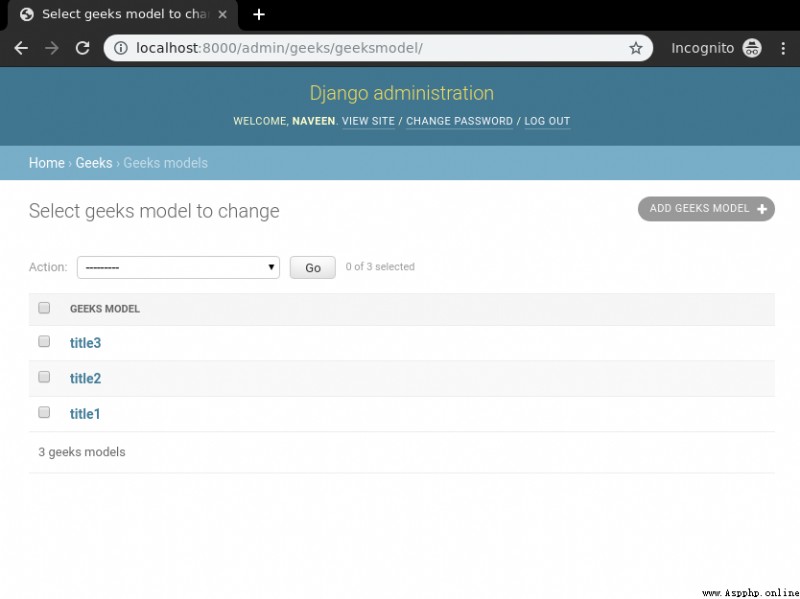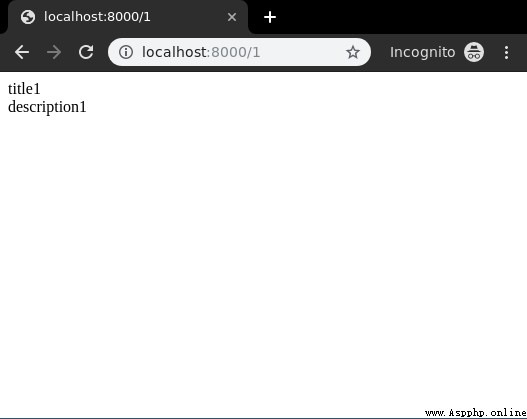A detail view is a view ( Logic ), Used to display specific instances of tables in the database and all necessary details . It is used to display multiple types of data on a single page or view , For example, the user's profile .Django Provides exceptional support for detailed views , But let's examine how it is done manually through a function - based view . This article focuses on Detail View an , Which involves Django Forms、Django Models And so on . For detailed views , We need a project with some models and multiple instances , They will be displayed .
Django Detail view —— Function based view
How to use examples to create and use detailed views Explanation . Consider a person named geeksforgeeks Project , It has a name called geeks Applications for .
After you have a project and an application , Let's create a model , We will create an instance of it from our view . stay geeks/models.py in ,
# Import standards from built-in Libraries Django Model
from django.db import models
# Declare a “GeeksModel” The new model of
class GeeksModel(models.Model):
# The model field
title = models.CharField(max_length = 200)
description = models.TextField()
# Rename the instance of the model with the title name
def __str__(self):
return self.title After creating this model , We need to run two commands to create a database for it .
Python manage.py makemigrations
Python manage.py migrate Now let's use shell Create some instances of this model , Run the form bash,
Python manage.py shell Enter the following command
>>> from geeks.models import GeeksModel
>>> GeeksModel.objects.create(
title="title1",
description="description1").save()
>>> GeeksModel.objects.create(
title="title2",
description="description2").save()
>>> GeeksModel.objects.create(
title="title3",
description="description3").save() Now we are ready for the back end . Verify that the has been removed from http://localhost:8000/admin/geeks/geeksmodel/ Create examples

about detail_view, Some identification is required to get a specific instance of the model . Usually it is the only primary key , for example id. To specify this ID , We need to be in urls.py It's defined in . go to geeks/urls.py,
from django.urls import path
# importing views from views..py
from .views import detail_view
urlpatterns = [
path('<id>', detail_view ),
] Let's create a view and template for it . stay geeks/views.py in ,
from django.shortcuts import render
# Relative import of tables
from .models import GeeksModel
# from url Pass on id attribute
def detail_view(request, id):
# Initial data dictionary with field name as key
context ={}
# Add dictionary during initialization
context["data"] = GeeksModel.objects.get(id = id)
return render(request, "detail_view.html", context) stay templates/Detail_view.html Create a template in ,
<div class="main">
<!-- Specify fields to be displayed -->
{{ data.title }}<br/>
{{ data.description }}<br/>
</div> Let's check http://localhost:8000/1

The detailed view works normally . You can also display the selected fields according to the type of use required in various forms . Usually not id Used to define detailed views , It is slug.
 about detail_view, Some identification is required to get a specific instance of the model . Usually it is the only primary key , for example id. To specify this ID , We need to be in urls.py It's defined in . go to geeks/urls.py,
about detail_view, Some identification is required to get a specific instance of the model . Usually it is the only primary key , for example id. To specify this ID , We need to be in urls.py It's defined in . go to geeks/urls.py, 